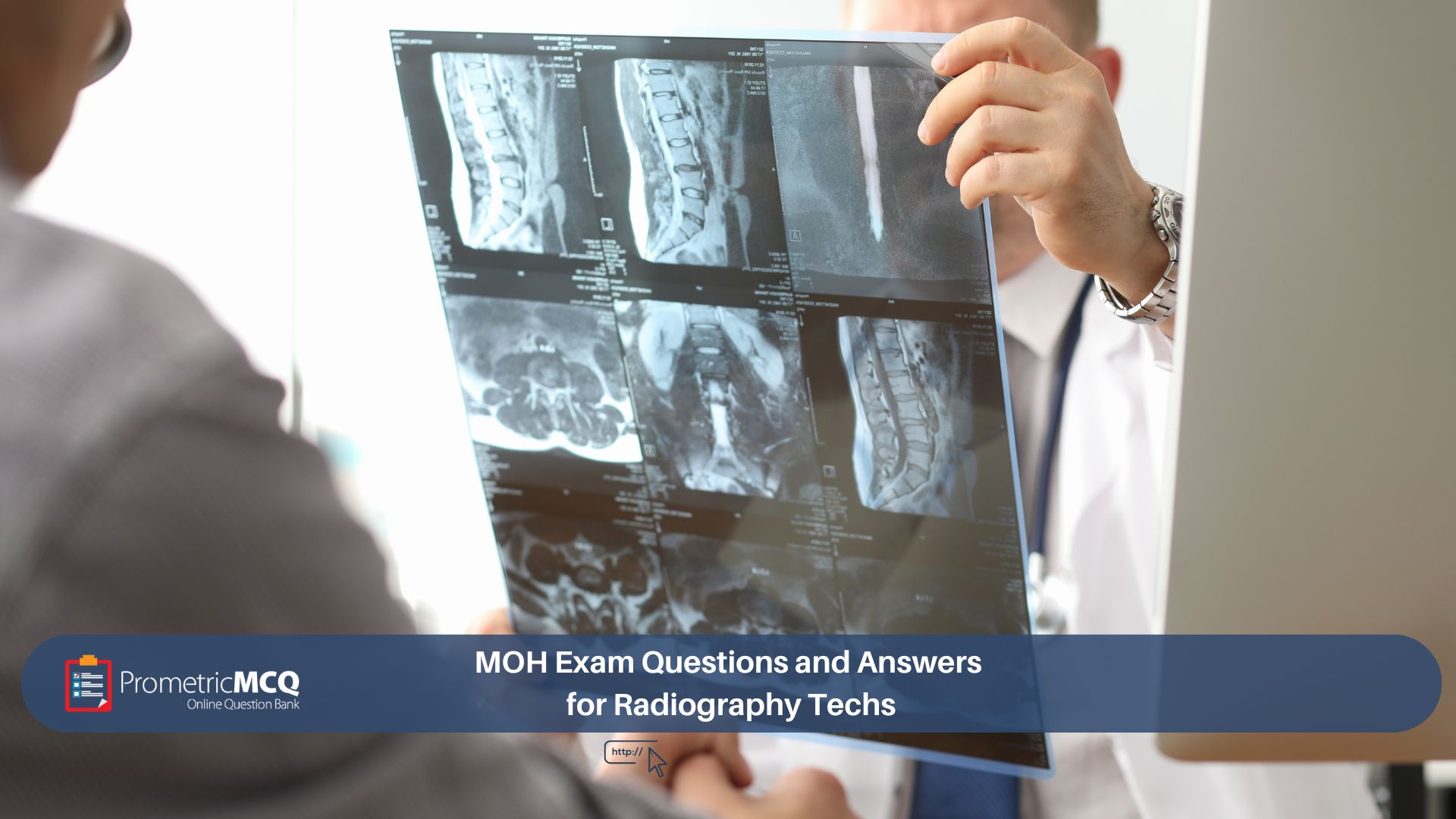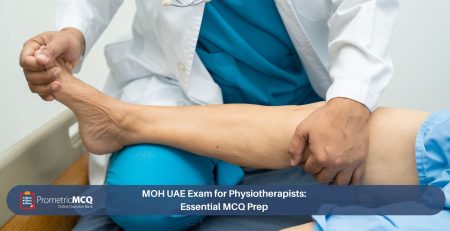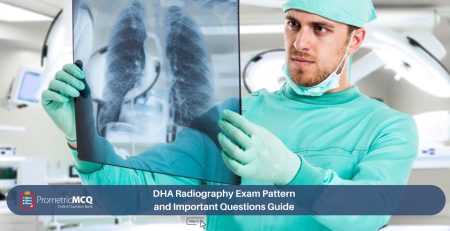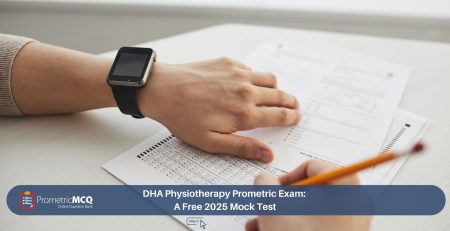
MOH Exam Questions and Answers for Radiography Techs
fatima@prometricmcq.com2025-09-15T13:02:35+00:00Table of Contents
ToggleMOH Exam Questions and Answers for Radiography Techs
For skilled radiography technologists, the UAE’s advanced healthcare sector offers a compelling career path, defined by modern technology and high standards of practice. To join this respected field in the Northern Emirates, passing the Ministry of Health and Prevention (MOH) Radiography Exam is the essential first step. This exam is not a simple test of textbook knowledge but a rigorous evaluation of your technical skills, clinical reasoning, and unwavering commitment to patient and radiation safety.
The key to conquering the MOH exam lies in understanding its structure and practicing with questions that mirror the real test. The exam is built around scenario-based Multiple-Choice Questions (MCQs) that challenge your ability to apply theoretical knowledge to practical, everyday situations in a busy imaging department. Success is achieved by mastering the concepts behind the questions, not just memorizing answers.
This ultimate 2025 guide is your comprehensive resource for this challenge. We will dissect the MOH Radiography Exam blueprint, illuminate the highest-yield topics, and provide a valuable collection of free, updated exam questions with detailed, explanatory answers. This guide is designed to be your primary tool for understanding the exam’s complexities and building the confidence needed for a first-attempt pass. Before you begin, familiarize yourself with the full journey by reading our MOH Examination Guide.
Key Takeaways for MOH Radiography Exam Success
- Radiation Safety is Supreme: The ALARA (As Low As Reasonably Achievable) principle is the foundation of many questions. Master concepts of time, distance, and shielding.
- Positioning Must Be Perfect: Expect highly specific questions on patient positioning for various radiographic procedures, including the central ray location, anatomical landmarks, and evaluation criteria for a good image.
- Know Your Physics: A solid understanding of the physics of x-ray production, beam characteristics (kVp, mAs), and equipment operation (grids, AEC) is essential.
- Image Quality and Artifacts: Be able to identify common image artifacts and know how to correct the technical errors that cause them.
- Patient Care is Key: Questions will cover patient communication, consent, and managing contrast media reactions.
Deconstructing the MOH Radiography Exam Blueprint
A successful study strategy begins with a deep understanding of the exam’s content domains. The MOH exam for Radiography Technologists is a computer-based test (CBT) that assesses your competence across the full spectrum of modern imaging practice.
| Core Domain | High-Yield Topics and Concepts for 2025 |
|---|---|
| Radiographic Procedures & Patient Positioning | This is a massive domain. It includes standard positioning for all skeletal radiography (skull, spine, extremities, pelvis), chest, and abdomen. You must know specific views (e.g., AP, lateral, oblique, tangential), central ray angulation and centering points, and the anatomical structures best demonstrated in each view. |
| Image Production, Evaluation & Equipment | Physics of x-ray production (bremsstrahlung, characteristic radiation). The relationship between kVp (contrast, penetration) and mAs (density). Function and use of grids, Automatic Exposure Control (AEC), and digital radiography systems (CR/DR). Image quality factors (density, contrast, spatial resolution, distortion) and identifying/correcting errors. |
| Radiation Protection (ALARA) | The cardinal principles: Time, Distance, Shielding. Collimation, filtration, and using high kVp/low mAs techniques. Personnel monitoring devices (dosimeters), radiation dose units (Sv, Gy), and deterministic vs. stochastic effects of radiation. Specific protection measures for pediatric and pregnant patients. |
| Patient Care, Safety & Ethics | Patient identification and consent. Patient assessment and communication. Handling of sterile fields, infection control protocols, and basic life support (BLS). A critical area is the management of adverse reactions to iodinated contrast media, from mild to severe anaphylactic shock. |
| Specialized Imaging Procedures | While the focus is on general radiography, you should have foundational knowledge of other modalities. This includes patient safety considerations in MRI (magnetic fields), basic principles of CT (cross-sectional imaging), and common fluoroscopic procedures (e.g., Barium studies). |
For every positioning question, visualize the patient, the tube, and the image receptor. Trace the path of the central ray and picture the anatomy that will be projected. This mental rehearsal is a powerful study tool.
Free MOH Radiography Exam Questions and Answers
Use these questions to test your knowledge and, more importantly, to understand the style of reasoning the exam requires. Analyze the rationales carefully to solidify your understanding.
Question 1: Radiographic Positioning
A patient is sent for a PA axial projection of the skull using the Caldwell method. To correctly project the petrous ridges into the lower third of the orbits, how should the central ray be angled?
- Perpendicular to the image receptor
- 15 degrees caudad
- 15 degrees cephalad
- 25 degrees caudad
Correct Answer: B
Rationale: The Caldwell method is specifically designed to visualize the frontal bone, ethmoid sinuses, and orbital rims while projecting the dense petrous portions of the temporal bones below the orbits. This is achieved by angling the central ray 15 degrees caudad (downward) to exit at the nasion, with the patient’s head positioned with the orbitomeatal line (OML) perpendicular to the image receptor.
Why other options are incorrect:
A: A perpendicular ray (0 degrees) would project the petrous ridges directly over the orbits, obscuring key structures.
C: A cephalad angle would project the petrous ridges even higher up in the orbits, making the image non-diagnostic for its intended purpose.
D: A 25-30 degree caudad angle is used for the Towne method (AP axial), which is designed to visualize the occipital bone and foramen magnum.
Question 2: Radiation Protection
According to the principle of ALARA, which of the following is the single most effective method a radiographer can use to reduce radiation dose to a patient?
- Using a high-ratio grid
- Increasing the source-to-image distance (SID)
- Strict collimation of the x-ray beam to the area of interest
- Providing lead shielding to the patient’s family member in the room
Correct Answer: C
Rationale: While all radiation safety practices are important, strict collimation is the most effective way to reduce the patient’s integral dose. By limiting the size of the x-ray beam to only the anatomy of interest, you reduce the total volume of tissue being irradiated, which directly decreases the patient’s overall dose and minimizes the risk of stochastic effects. It also has the secondary benefit of improving image quality by reducing scatter radiation.
Why other options are incorrect:
A: Using a high-ratio grid requires an *increase* in mAs to maintain image density, which in turn *increases* patient dose.
B: Increasing SID reduces dose according to the inverse square law, but it is not as impactful as collimation, which limits the primary beam itself. An increase in SID also requires a compensatory increase in mAs.
D: Shielding a family member is crucial for their protection but does nothing to reduce the dose received by the patient.
Question 3: Image Production & Evaluation
A radiograph of the chest is produced with a high kVp and low mAs technique. What is the primary characteristic of the resulting image?
- High patient dose and short scale of contrast
- Low patient dose and short scale of contrast
- High patient dose and long scale of contrast
- Low patient dose and long scale of contrast
Correct Answer: D
Rationale: High kVp techniques have two major effects. First, higher energy photons are more penetrating, meaning a lower mAs (quantity of x-rays) is needed to achieve the desired image density. This directly reduces the radiation dose to the patient. Second, a high kVp beam produces a wider range of photon energies, which results in more shades of gray on the final image. This is known as a long scale of contrast (or low contrast), which is ideal for chest radiography as it allows visualization of the subtle differences between lung tissue, vasculature, and the mediastinum.
Question 4: Patient Care & Safety
A patient who has just received an injection of iodinated contrast media for a CT scan begins to complain of itching and develops hives (urticaria) on their arms. They are alert and their vital signs are stable. What is the technologist’s most appropriate immediate action?
- Administer a dose of epinephrine immediately.
- Tell the patient it’s a normal reaction and proceed with the scan.
- Stop the injection (if ongoing), provide reassurance, and notify the radiologist.
- Start chest compressions and call a code.
Correct Answer: C
Rationale: Itching and hives are signs of a mild allergic-like reaction to contrast media. While not immediately life-threatening, it has the potential to progress. The technologist’s role is to first stop the administration of any further contrast, calmly reassure the patient, and immediately notify the supervising radiologist or physician. The physician will then decide on the appropriate medical management, which may include administering an antihistamine. The technologist should not administer medication independently.
Why other options are incorrect:
A: Epinephrine is reserved for severe, life-threatening anaphylactic reactions involving respiratory distress or hypotension.
B: While these reactions can be mild, they are not “normal” and should never be ignored. The scan should be paused until the patient is assessed by a doctor.
D: Chest compressions are for cardiac arrest. The patient is alert with stable vital signs.
Frequently Asked Questions (FAQs) for the MOH Radiography Exam
The MOHAP issues a “Pass” or “Fail” result without a numerical score. Based on expert analysis and candidate feedback, the unofficial passing benchmark is estimated to be around 60%. A wise strategy is to consistently score above 70% in high-quality practice exams to ensure you have a safe margin for success.
The exam typically features 150 multiple-choice questions, and you are given 165 minutes to complete it. This requires efficient time management, averaging just over a minute per question.
The exam is for general radiography technologists, so the vast majority of questions will be on conventional x-ray procedures, physics, and safety. However, you are expected to have a foundational understanding of patient safety principles for other modalities, such as MRI safety zones and basic CT terminology. You will not be asked highly advanced technical questions about these modalities.
No, there is no penalty for incorrect answers. Your score is based solely on the number of correct responses. Therefore, you should answer every single question, even if you have to make an educated guess.
Primary Source Verification (PSV) is a mandatory step where the DataFlow Group independently verifies your credentials (education, license, experience) with the issuing institutions. This process runs parallel to your exam preparation and must be completed before your UAE MOH license can be activated. You can learn more in our detailed guide on the MOH application process.
Combine textbook learning (e.g., from Merrill’s Atlas) with active visualization. For each position, don’t just memorize the text. Look at the example radiographs, identify the key anatomical structures, and understand *why* a specific angle or patient position is required to demonstrate that anatomy without superimposition.
They are very important. You should know the annual occupational dose limit for radiation workers and the public. Be familiar with the SI units for radiation measurement: Gray (Gy) for absorbed dose and Sievert (Sv) for equivalent/effective dose. This knowledge is fundamental to radiation safety, a core topic of the exam.
The exam reflects high international standards of radiation protection and patient care. The principles are universal. Familiarity with the recommendations from the International Atomic Energy Agency (IAEA) on radiation protection of patients is highly beneficial as it forms the basis of best practices worldwide.
You are generally allowed three attempts to pass the exam. After a failed attempt, you can typically reapply to take the exam again after a short waiting period, but you will need to pay the exam fee again. It’s crucial to analyze your weak areas and prepare thoroughly before your next attempt.
No, and it is highly recommended that you complete the entire process—from initial application and DataFlow to passing the exam—before you begin your job search. Most employers in the UAE will prioritize hiring candidates who are already “MOH-Eligible,” meaning they have passed the exam and have their eligibility letter.
Conclusion: Imaging Your Future in the UAE
The MOH Radiography Exam is a comprehensive test of your skills as a modern imaging professional. Success is not a matter of chance; it is the result of a structured and disciplined preparation strategy. By focusing on the high-yield topics of positioning, safety, and image production, and by dedicating significant time to practicing with high-quality MCQs, you can build the knowledge and confidence to excel. Use this guide and its sample questions as a launchpad for your studies, and you will be well on your way to earning your license and beginning a successful career in the UAE’s dynamic healthcare sector.
Ready to Focus Your Preparation and Ensure a Pass?
Gain a critical advantage with our comprehensive question bank, featuring hundreds of MOH-style MCQs, detailed rationales, and mock exams that simulate the real test environment.










